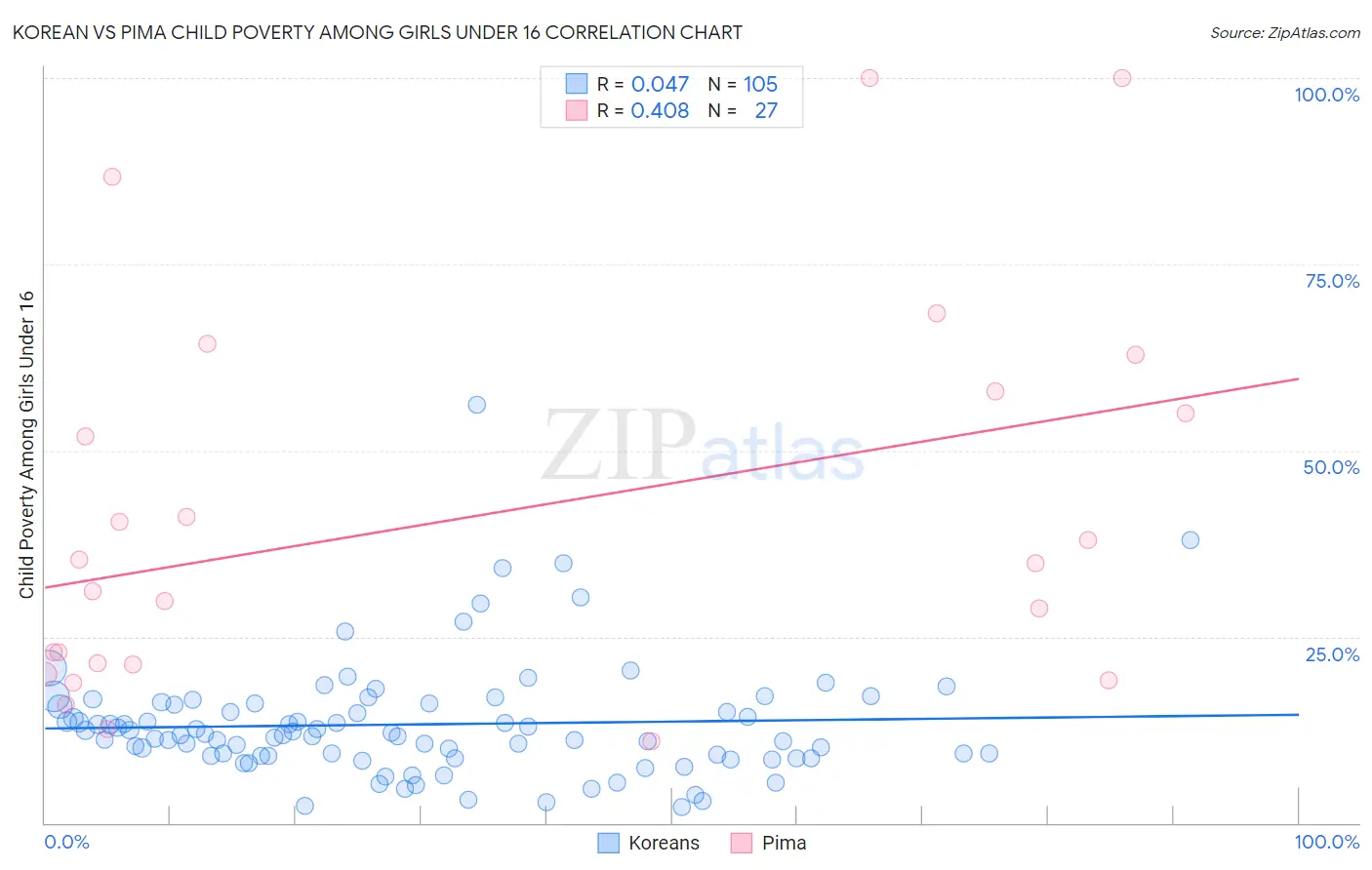Korean vs Pima Child Poverty Among Girls Under 16
COMPARE
Korean
Pima
Child Poverty Among Girls Under 16
Child Poverty Among Girls Under 16 Comparison
Koreans
Pima
14.1%
CHILD POVERTY AMONG GIRLS UNDER 16
99.4/ 100
METRIC RATING
43rd/ 347
METRIC RANK
28.2%
CHILD POVERTY AMONG GIRLS UNDER 16
0.0/ 100
METRIC RATING
342nd/ 347
METRIC RANK
Korean vs Pima Child Poverty Among Girls Under 16 Correlation Chart
The statistical analysis conducted on geographies consisting of 497,455,609 people shows no correlation between the proportion of Koreans and poverty level among girls under the age of 16 in the United States with a correlation coefficient (R) of 0.047 and weighted average of 14.1%. Similarly, the statistical analysis conducted on geographies consisting of 61,453,639 people shows a moderate positive correlation between the proportion of Pima and poverty level among girls under the age of 16 in the United States with a correlation coefficient (R) of 0.408 and weighted average of 28.2%, a difference of 100.9%.

Child Poverty Among Girls Under 16 Correlation Summary
| Measurement | Korean | Pima |
| Minimum | 2.1% | 11.0% |
| Maximum | 56.1% | 100.0% |
| Range | 54.0% | 89.0% |
| Mean | 13.2% | 41.2% |
| Median | 11.8% | 34.9% |
| Interquartile 25% (IQ1) | 9.0% | 21.2% |
| Interquartile 75% (IQ3) | 16.0% | 57.9% |
| Interquartile Range (IQR) | 7.0% | 36.7% |
| Standard Deviation (Sample) | 7.8% | 25.6% |
| Standard Deviation (Population) | 7.8% | 25.1% |
Similar Demographics by Child Poverty Among Girls Under 16
Demographics Similar to Koreans by Child Poverty Among Girls Under 16
In terms of child poverty among girls under 16, the demographic groups most similar to Koreans are Immigrants from Scotland (14.0%, a difference of 0.14%), Immigrants from Asia (14.1%, a difference of 0.14%), Immigrants from Sri Lanka (14.0%, a difference of 0.31%), Immigrants from Bolivia (14.0%, a difference of 0.31%), and Immigrants from Australia (14.0%, a difference of 0.40%).
| Demographics | Rating | Rank | Child Poverty Among Girls Under 16 |
| Russians | 99.6 /100 | #36 | Exceptional 13.9% |
| Lithuanians | 99.6 /100 | #37 | Exceptional 13.9% |
| Immigrants | Moldova | 99.6 /100 | #38 | Exceptional 13.9% |
| Immigrants | Australia | 99.5 /100 | #39 | Exceptional 14.0% |
| Immigrants | Sri Lanka | 99.5 /100 | #40 | Exceptional 14.0% |
| Immigrants | Bolivia | 99.5 /100 | #41 | Exceptional 14.0% |
| Immigrants | Scotland | 99.4 /100 | #42 | Exceptional 14.0% |
| Koreans | 99.4 /100 | #43 | Exceptional 14.1% |
| Immigrants | Asia | 99.4 /100 | #44 | Exceptional 14.1% |
| Immigrants | Greece | 99.3 /100 | #45 | Exceptional 14.1% |
| Croatians | 99.3 /100 | #46 | Exceptional 14.1% |
| Immigrants | Czechoslovakia | 99.3 /100 | #47 | Exceptional 14.2% |
| Czechs | 99.3 /100 | #48 | Exceptional 14.2% |
| Greeks | 99.2 /100 | #49 | Exceptional 14.2% |
| Immigrants | Israel | 99.2 /100 | #50 | Exceptional 14.2% |
Demographics Similar to Pima by Child Poverty Among Girls Under 16
In terms of child poverty among girls under 16, the demographic groups most similar to Pima are Hopi (27.9%, a difference of 1.3%), Yuman (27.1%, a difference of 4.2%), Immigrants from Yemen (29.5%, a difference of 4.5%), Crow (26.4%, a difference of 7.1%), and Cheyenne (26.3%, a difference of 7.4%).
| Demographics | Rating | Rank | Child Poverty Among Girls Under 16 |
| Blacks/African Americans | 0.0 /100 | #333 | Tragic 24.7% |
| Menominee | 0.0 /100 | #334 | Tragic 25.0% |
| Pueblo | 0.0 /100 | #335 | Tragic 25.2% |
| Sioux | 0.0 /100 | #336 | Tragic 25.6% |
| Yup'ik | 0.0 /100 | #337 | Tragic 25.8% |
| Cheyenne | 0.0 /100 | #338 | Tragic 26.3% |
| Crow | 0.0 /100 | #339 | Tragic 26.4% |
| Yuman | 0.0 /100 | #340 | Tragic 27.1% |
| Hopi | 0.0 /100 | #341 | Tragic 27.9% |
| Pima | 0.0 /100 | #342 | Tragic 28.2% |
| Immigrants | Yemen | 0.0 /100 | #343 | Tragic 29.5% |
| Navajo | 0.0 /100 | #344 | Tragic 30.5% |
| Lumbee | 0.0 /100 | #345 | Tragic 30.7% |
| Tohono O'odham | 0.0 /100 | #346 | Tragic 31.6% |
| Puerto Ricans | 0.0 /100 | #347 | Tragic 32.7% |